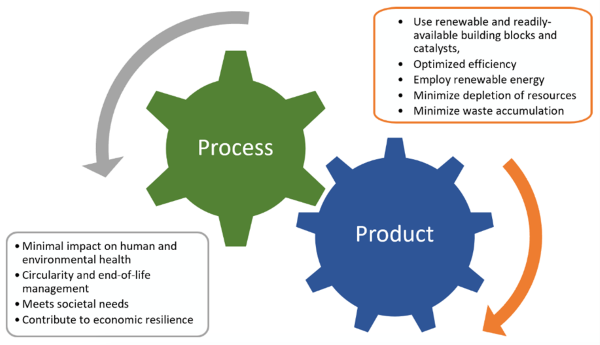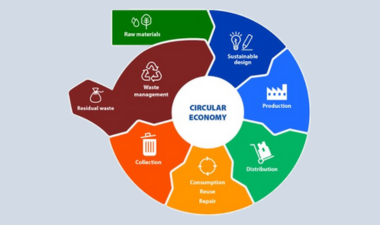Sustainable Chemistry
A broader perspective on chemistry which includes meeting societal needs, creating economic resilience, and taking a holistic view of the full life cycle of products and processes.
What is Sustainable Chemistry?
Sustainable Chemistry is "the development and application of chemicals, chemical processes, and products that benefit current and future generations without harmful impacts to humans or ecosystems."¹
In “Sustainable Chemistry Report: Framing the Federal Landscape,” the National Science and Technology Council further defines sustainable chemistry as chemistry that:
- uses readily available and renewable building blocks, reagents, and catalysts;
- uses a process optimized for efficiency and employs renewable energy sources;
- manages chemicals, materials, and products across the lifecycle with intentional design, manufacture, use, and end-of-life;
- does not adversely impact human health or the environment;
- promotes circularity and aspires to perpetually use materials without depleting resources or accumulating waste;
- meets societal needs and;
- contributes to economic resilience.

Key facets of sustainable chemistry relating the rational design of a product with the required functional characteristics and the process used to produce it.
The need for rational design, circularity, and end-of-life considerations are key for sustainable chemistry.
What is Rational Design?
This resource from ACS GCI explores rational molecular design—the use of information from empirical, mechanistic, and computational methods to create chemicals that are less toxic to humans and the environment.
The Circular Economy
The Circular Economy: Find out what it means and how it benefits you, the environment, and our economy.
What is Life Cycle Thinking?
What is the true impact of a chemical product? Life cycle management means thinking about the environmental, social, and economic impacts of a product over its entire life cycle.
How does the definition of sustainable chemistry compare to the definition of “green chemistry”?
At first glance, green chemistry seems to focus more closely on the reduction or elimination of hazardous materials and waste generation over a product's lifecycle. After The 12 Principles of Green Chemistry were published, the concept of “circular economy” emerged. With this evolution, it became important to add new terminology. Sustainable chemistry is roughly equivalent to the combined principles of green chemistry and circular economy.
Sustainable chemistry promotes making meaningful advances in energy and material use optimization. For a more sustainable future, we need more fundamental research on how we drive chemical reactions. This includes the effective use of light, stored electrons (electrochemistry; battery technology), and even mechanical force for specific chemical transformations. In addition, advances in the use of abundant metal catalysts and biological catalysts are important for more sustainable reaction procedures.
By bringing awareness to the power of green and sustainable chemistry and empowering chemists with the toolset of green chemistry, we can bring about more equitable and sustainable economic development.

© 2024 American Chemical Society


